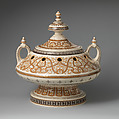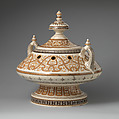Potpourri
After Charles Toft British
Manufactory Minton(s) British
Not on view
In the mid-Victorian era there was great interest in the decorative styles of the sixteenth century, which is reflected in many fields and even in women's fashions. The leading firm of Mintons made copies of the rare sixteenth-century French court ceramics then known as "Henri II" ware. Such copies were first produced by Leon Arnoux, the factory's French art director. In the late 1860s Toft, a member of a line of prominent seventeenth-century potters, turned out exact reproductions at Mintons of sixteenth century models, with dark clay ornament inlaid on a white body-the equivalent of niello on silver-and also larger, original works. The latter, very much to contemporary taste in form, utilized a second technique practiced at the "Henri II" workshop, now almost universally recognized as having been at Saint-Porchaire, a village in Poitou.
This second technique consisted of painting on the surface of the white body with colored stains, which were then given brilliance by a clear lead glaze. While the shape of this potpourri is orientalizing, the symmetrical decorationis taken with little
adaptation from Saint-Porchaire orginals, including the repeated H around the foot, a reference to the king found on numerous pieces of the earlier period.
Due to rights restrictions, this image cannot be enlarged, viewed at full screen, or downloaded.
This artwork is meant to be viewed from right to left. Scroll left to view more.



